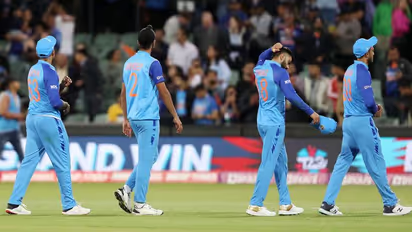India knocked out of ICC T20 World Cup 2022: Analysing the 5 reasons for failure

Synopsis
ICC T20 World Cup 2022: India was knocked out in the semis by England in Adelaide on Thursday. As India waits for its second T20WC title, we analyse the five reasons for its failure this term.
Team India has not had the best outing on the global stage yet again. Its stint in the 2022 ICC T20 World Cup has reached a premature end. On Thursday, it was humiliated by fellow former world champion England at the Adelaide Oval, ending its hunt for its second T20WC title. Notably, it ended on an embarrassing note, as the Three Lions got the job done by ten wickets. While India was one of the favourites to enter the final and lift the title, it has failed to reach the tournament's final since 2014. As a result, fans wonder what is going wrong with Men in Blue, while we analyse five reasons for it.
Lack of attacking approach from the openers
As evident in this tie, the Indian openers did not get on an attacking note from the start, thus leaving the PowerPlay unutilised. While it was acceptable for the opening few games, retaining the same watchful approach, especially on the Adelaide track, was baffling. In contrast, the English openers went in with attacking intent, and the result is right in front.
CATCH ALL ICC T20 WORLD CUP 2022 UPDATES HERE
Yuzvendra Chahal deserved a chance
It is known that spinners are not entirely effective on the Australian wickets. However, it debunks that India's current top Twenty20 (T20) spinner Chahal did not deserve a chance. On the Adelaide track, which behaves like sub-continent wickets, Chahal could have been somewhat effective in pushing the brakes onto the explosive English run chase. However, with most English batters capable of playing sweep, it is still being determined how much would have Chahal been effective.
Is Team India working in silos?
According to Cricbuzz, the Indians were working in pairs during the English chase, with Pandya dealing with Suryakumar Yadav, Rohit dealing with Pant and Bhuvneshwar Kumar dealing with Axar Patel. While there are no conclusive reports of any rift between players, the onus to make calls should only be upon the captain and the bowler, while the others should abide by the fielding calls made by the skipper.
India's bowling looked clueless
India's bowling was always a concern heading into the tournament, as its death bowling was heavily criticised. But, as the event progressed, the Indian bowling failed to fire even in the opening stage of the innings, while middle-overs were the only phase where they were effective. As clueless as India's bowling looks, head coach Rahul Dravid needs to ensure a transition in the department.
Dravid might not be made to be a T20 coach
Dravid is a legend in himself, having dominated Tests and One-Day Internationals (ODIs) during his career. He greatly understands the two formats both as a player and a coach. However, given his lack of engagement with the Twenty20 (T20) format, he may not be cut out to guide the side in the shortest format, while someone like Michael Hussey could be a great contender.
Stay on top of all the latest Sports News, including Cricket News, Football News, WWE News, and updates from Other Sports around the world. Get live scores, match highlights, player stats, and expert analysis of every major tournament. Download the Asianet News Official App to never miss a sporting moment and stay connected to the action anytime, anywhere.